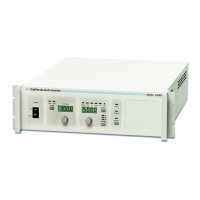Programming the Output
Power-on Initialization
When the AC source is first turned on, it wakes up with the output state defined by the PON
register number. If the register number or the register has no valid data, the AC source
initializes to the following state.
VOLT 5.0
FREQ 60
OUTP 0
VOLT:RANG 135
The following commands are given implicitly at power-on:
*RST
*CLS
*SRE 128
*ESE 0
*RST is a convenient way to program all parameters to a known state. Refer to Table 10-4
under the *RST command in paragraph 10.10.6 to see how each programmable parameter
is set by *RST.
Enabling the Output
To enable the output, use the command:
OUTP 1
Voltage and Frequency
The AC rms output voltage is controlled with the VOLTage command. For example, to set
the AC output voltage for all three phases to 125 volts rms, use:
VOLT 125
The maximum voltage that the AC source can output is limited by the rms value of the
waveform. This value is defined by the LIMIT subsystem.
Voltage Ranges
The power source has two voltage ranges that are controlled by relays. The command that
controls the range is:
VOLTage:RANGe 135 | 270
When the range is set to (135), the maximum rms voltage that can be programmed is 135
volts rms, but it is only on this range that the maximum output current rating is available.
The VOLT:RANGe command is coupled with the CURRent command. This means that the
maximum current limit that can be programmed at a given time depends on the voltage
range setting in which the unit is presently operating.
Frequency
The output frequency is controlled with the FREQuency command. To set the output
frequency to 400 Hz, use:
FREQuency 400

